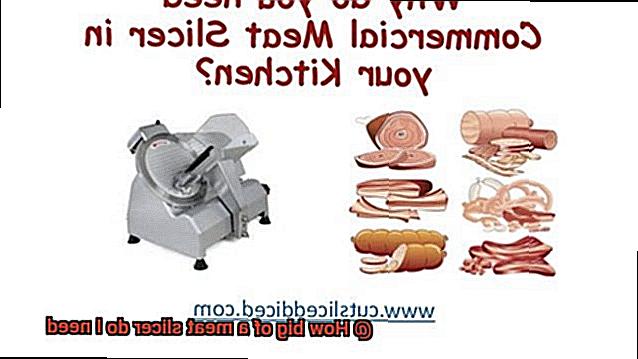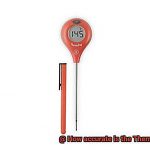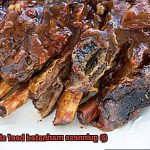Are you a meat lover who enjoys cooking up a storm in the kitchen? Or perhaps you’re a professional chef who needs to slice meat on a daily basis? Whatever your situation, having a high-quality meat slicer can make all the difference when it comes to efficiency and precision in the kitchen. But with so many different sizes available, how do you know which one is right for you?
Choosing the perfect size of meat slicer can be quite daunting, as there are several factors to consider. For instance, how often will you use it? What types of meats do you typically slice? And how much do you need to slice at once? Opting for a machine that’s too small could leave you struggling with tougher cuts of meat, while choosing one that’s too large might take up too much space and be difficult to manage.
That’s where we come in. In this blog post, we’ll delve into the various sizes of meat slicers on offer and help you determine what size is ideal for your needs. We’ll cover everything from blade size and motor power to overall capacity and more – all with an eye toward helping you make an informed decision when purchasing your next meat slicer. So let’s get started and find out exactly how big of a meat slicer you need.
Contents
How Much Meat Will You Be Slicing?
Your choice of the perfect meat slicer can impact the quality of your meat slices and efficiency of your slicing process.
First things first, let’s talk about home use. If you’re a casual user who only plans on slicing small amounts of meat occasionally, a smaller slicer with a blade size of 7-8 inches and a motor power of 100-130 watts should suffice. This size is perfect for slicing deli meats, cheeses, and vegetables.
However, if you plan on slicing larger cuts of meat such as roasts or hams, you’ll require a larger slicer. A 10-inch blade with a motor power of 200-250 watts is ideal for this purpose. It can handle the heavier workload and produce more consistent slices.
When it comes to commercial use, the volume of meat being sliced will determine the size of the slicer you need. For high-volume restaurants or delis, larger slicers ranging from 12-14 inches in blade size and motor power upwards of 300 watts are necessary to handle constant demand.
Another crucial factor to consider when purchasing a meat slicer is the thickness of your meat slices. Smaller slicers may not be able to handle thicker cuts, while larger machines with more powerful motors can slice through thicker meats with ease.
You should also consider the space available for your slicer before making a purchase. Larger machines will require more counter space and storage room when not in use. It’s better to choose a slightly larger machine than you think you need just to be on the safe side. This ensures that you have enough power and capacity to handle any slicing needs that may arise in the future.
The Size of the Slicer Blade Matters
If you’re looking to invest in a meat slicer, it’s important to know that the size of the slicer blade matters. As a meat slicing expert, I can tell you that selecting the right blade size is crucial for achieving perfect slices every time.
Meat slicers come with blades ranging from 8 inches to 14 inches in diameter. Larger blades can handle more meat, but they can also be more challenging to handle and clean. When selecting a blade size, consider the volume of meat you’ll be slicing. If you plan to use the slicer occasionally for home use or small gatherings, an 8-inch blade may suffice. However, if you’re running a restaurant or catering business and need to slice large quantities of meat, a larger blade may be necessary.
Thickness is another critical factor to consider when choosing a blade size. Larger blades typically have more thickness settings and can cut thicker slices than smaller ones. If you need to slice thicker meats such as roasts or hams, then a larger blade may be more suitable.
It’s essential to note that larger blades require more powerful motors to handle the increased workload. This means that if you opt for a bigger blade, you may need to invest in a more potent motor, which can increase the overall cost of the meat slicer.
Consider the Thickness of Your Slices
When it comes to selecting a meat slicer, don’t overlook the importance of slice thickness. As an expert in the field, I can tell you that finding the right machine for your needs is about more than just blade size. You need a slicer that can handle the thickness of your cuts with ease, whether you’re slicing deli meats or thick cuts of roast.
Let’s start with thinner cuts. For deli meats or vegetables, a smaller and less powerful slicer will do the trick. These machines typically have a blade diameter of 7-9 inches and can handle slices up to 1/2 inch thick. No need to invest in a larger and more powerful slicer if you’re primarily slicing these types of foods.
But if you’re slicing thicker cuts of meat like roasts or hams, you’ll need a larger and more powerful slicer. A blade diameter of 10-14 inches is ideal for these types of meats, and your slicer should be able to handle slices up to 1 inch thick. Trust me on this one – trying to slice these meats with a smaller machine will only result in uneven slices or difficulty cutting through the meat at all.
Now, it’s important to note that bigger isn’t always better when it comes to meat slicers. If you primarily slice thinner cuts, investing in a larger machine may not be necessary. Plus, larger slicers take up more counter space and can be more difficult to clean and maintain.
So before making your purchase, consider the thickness of your slices and the types of meats and foods you plan on slicing regularly. By doing so, you’ll ensure that you invest in a machine that is both efficient and practical for your needs.
Storage Space for Your Meat Slicer
Today, let’s dive into the world of meat slicers and the storage space they require. As an expert in this field, I can attest that the size and weight of your slicer are crucial factors to consider when determining storage space.
For starters, take a look at your kitchen or butcher shop and assess the space available. If you’re tight on room, a compact model may be the best choice for you. Opt for models that are designed with practicality in mind, ones that can fit on a countertop or in a cabinet with ease. Some models even feature built-in storage compartments for blades and other accessories, keeping everything perfectly organized.
On the other hand, if you have ample space at your disposal, larger slicers might be more suitable for you. These heavy-duty machines often come with wider blades and more powerful motors, making them ideal for slicing larger cuts of meat. Heavier models also tend to be more stable and durable, perfect for those who plan on using their slicer in one location.
Another important factor to consider is how frequently you’ll need to move your slicer around. If you plan on transporting it often, opt for a lighter model that can be easily carried from one place to another. But if you primarily plan on using your slicer in one spot, a heavier model will provide stability and reliability.
Home Use vs Commercial Grade
When deciding between a home use or commercial grade meat slicer, there are several key factors to consider.
Home use meat slicers are smaller and more affordable than their commercial counterparts. They are perfect for slicing small amounts of meat for personal use, such as sandwiches or charcuterie boards. With blades ranging from 7-9 inches in diameter, they can easily slice meats up to 1/2 inch thick. However, if you’re looking to slice larger quantities of meat quickly and efficiently, a commercial grade slicer is the better choice.
Commercial grade meat slicers are larger and more powerful than home use models. They are designed to handle heavy and frequent use in restaurants, delis, and other food service establishments. With blades ranging from 10-14 inches in diameter, they can slice meats up to 1 inch thick with ease. While they may be more expensive than home use models, commercial grade slicers are much more durable and can withstand heavy use without breaking down.
When deciding which type of meat slicer to purchase, consider the frequency and quantity of your slicing needs. If you only plan on using your slicer occasionally for personal use, a home use model should suffice. But if you need a machine that can handle heavy use on a daily basis, a commercial grade slicer will be a worthwhile investment.
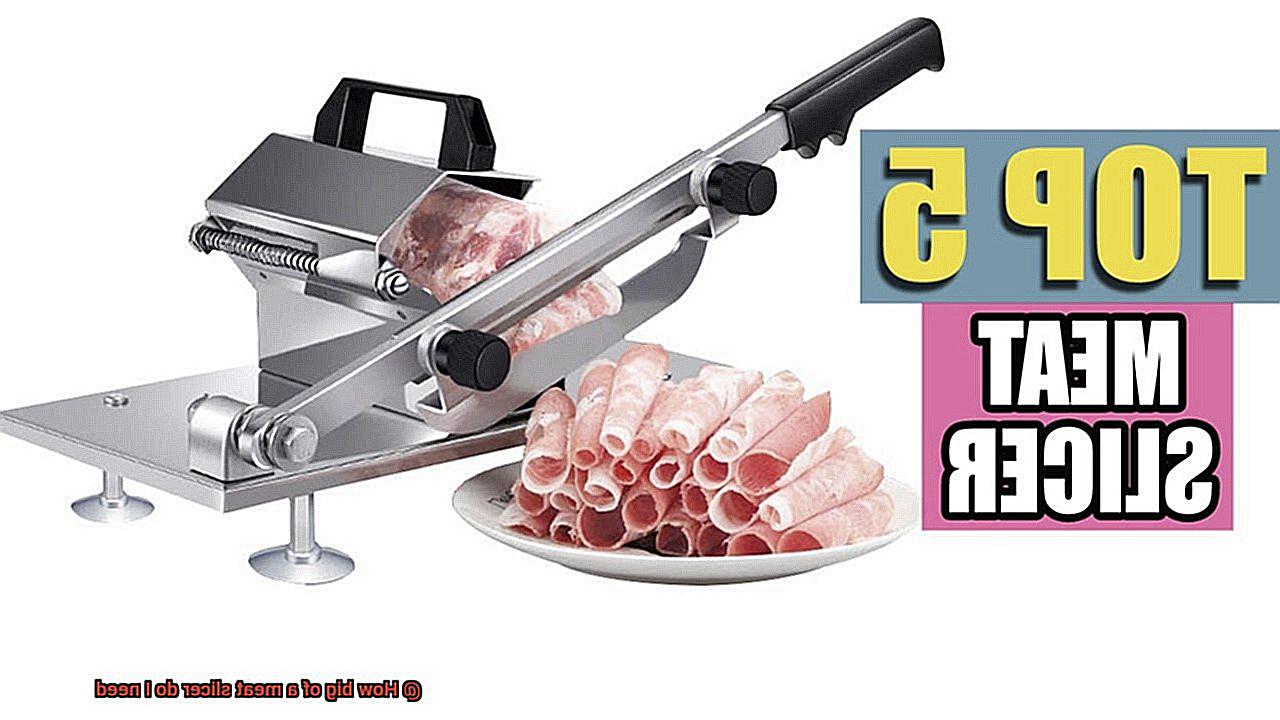
In addition to durability and power, commercial grade slicers also offer greater precision and versatility than home use models. They can slice meats at varying thicknesses and angles, making them a great choice for chefs who require consistent cuts of meat for their dishes.
Different Types of Meat Slicers
If so, investing in a meat slicer is a must. However, choosing from the different types of meat slicers available can be daunting. This article will explore the different types of meat slicers, their unique features, and benefits to help you make an informed decision.
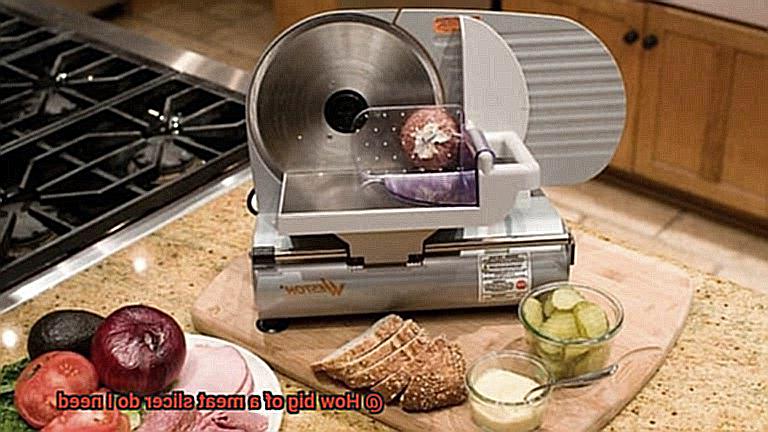
Manual Meat Slicers
If you’re looking for an entry-level option that’s also budget-friendly, a manual meat slicer may be your best bet. These slicers are hand-operated and require you to move the slicing blade back and forth across the meat. Although they may require more effort to use, they are ideal for slicing smaller amounts of meat and are perfect for home use. Additionally, they are compact and easy to clean.
Automatic Meat Slicers
For those who plan on slicing larger amounts of meat regularly, an automatic meat slicer may be the best option. They come equipped with an electric motor that powers the slicing blade, allowing you to slice through larger cuts of meat quickly and efficiently. Unlike manual slicers, these machines offer adjustable settings for slice thickness, making them more versatile than their manual counterparts. Though they are pricier than manual slicers, they are worth the investment if you need to slice large volumes of meat frequently.
Gravity-Fed Meat Slicers
When it comes to commercial kitchens or delis that demand efficiency and speed when slicing large quantities of food quickly, gravity-fed meat slicers take the lead. These machines use gravity to feed the meat onto the slicing blade, enabling you to slice through large cuts of meat effortlessly. They are easy to clean and maintain; however, their higher price point may deter some buyers.
Vertical Meat Slicers
Vertical slicers are perfect for slicing cured meats such as ham or bacon as they use a vertical blade that allows you to slice through the meat from the top down. They are also more compact than other types of meat slicers, which makes them ideal for home use or smaller commercial kitchens. However, they may not be as versatile as other types of meat slicers.
Accessories to Consider
This versatile tool will help you slice your favorite meats with ease. However, before making your final decision, it’s important to consider the accessories that will take your slicing game to the next level.
First on the list is a blade sharpener. A dull blade can quickly turn your slicing experience from fun to frustrating, resulting in uneven cuts. By investing in a blade sharpener, you can ensure that your slicer is always performing at its best and slicing with precision.
Next up is a food carriage extension. This accessory is a lifesaver if you plan on slicing larger cuts of meat or even whole hams or roasts. The extension provides additional support for the food being sliced, making the process easier, more efficient, and safer.
A food pusher is another accessory worth considering. It helps you push food through the slicer safely while ensuring that every last bit of food gets sliced, minimizing waste. This accessory is particularly useful when slicing small or oddly shaped pieces of meat.
Lastly, a catch tray is essential for any meat slicer. While some slicers come with built-in trays or platforms for catching sliced meat, investing in a separate catch tray is always a good idea. Not only does it make clean-up easier, but it also prevents sliced meat from falling onto your countertop or floor.
Tips for Choosing the Right Size Meat Slicer
Are you a meat lover who enjoys perfectly sliced meats every time? A meat slicer can make your life easier and your meats more evenly sliced. However, before you rush out to buy one, it’s important to consider the size that will best fit your needs.
Types of Meat
The first factor to consider when choosing the right size meat slicer is the types of meats you will be slicing. If you plan on slicing larger cuts of meat, such as roasts or hams, then a larger slicer with a bigger blade and carriage would be ideal. The size of the blade determines how thick or thin the cuts will be, and a bigger carriage can accommodate larger chunks of meat. However, if you only plan on slicing smaller cuts of meat like deli meats or cheeses, then a smaller slicer would suffice.
Frequency of Use
Another factor to consider is how often you will be using the slicer. If you plan on using it frequently or for large quantities of meat, a larger slicer with a more powerful motor may be necessary to handle the workload. A more powerful motor can slice through tougher meats with ease and speed up the process. However, if you only plan on using the slicer occasionally or for smaller quantities of meat, a smaller and less powerful slicer may be suitable.
Available Space
The amount of counter space available is also an important consideration when choosing the right size meat slicer. A larger slicer may require more space and can be more difficult to store when not in use, while a smaller slicer can fit easily on a countertop or in a cabinet. If you have limited counter space, a smaller and more compact model that can be easily stored away would be ideal.
Budget
Lastly, it is important to consider your budget when choosing the right size meat slicer. Larger and more powerful slicers tend to come with a higher price tag, so it is important to determine how much you are willing to spend before making a purchase. However, it’s important to keep in mind that investing in a high-quality machine can save you money in the long run by lasting longer and requiring less maintenance.
Err on the Side of Caution
In general, it’s better to choose a slightly larger machine than you think you need. This will ensure that you have enough power and capacity to handle any slicing needs that may arise in the future. It’s also important to choose a model with safety features like a blade guard and non-slip feet to prevent accidents.
Conclusion
In conclusion, the size of your meat slicer can make all the difference when it comes to achieving flawless slices. Whether you’re a home cook or a professional chef, selecting the right machine for your needs involves several important factors. You’ll need to take into account the amount of meat you’ll be slicing, as well as the types of meats and thicknesses you typically work with.
When shopping for a meat slicer, blade size is another key consideration. The blade determines the thickness of your cuts, so it’s important to choose one that matches your desired results. You’ll also want to factor in storage space, budget, and safety features when making your selection.
There are several different types of meat slicers on the market today, including manual, automatic, gravity-fed and vertical models. Each has its own unique features and benefits that cater to specific slicing needs. And don’t forget about accessories. Investing in items like a blade sharpener or food carriage extension can help elevate your slicing game even further.
One final piece of advice: always err on the side of caution when choosing a meat slicer. Opting for a slightly larger machine than you think you need will ensure that you have enough power and capacity to handle any future slicing needs that may arise.

